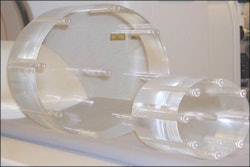Radiation exposure from CT was significantly lower when abdominal scans were performed in a dedicated pediatric radiology department compared to scans performed in a department serving both children and adults, researchers report in this month's Journal of the American College of Radiology.
After evaluating more than 600 scans performed at two centers, the researchers reported significant decreases in the estimated effective dose for abdominal and pelvic CT studies performed in the pediatric radiology department.
Strict adherence to low-dose protocols can be challenging in a department that serves both children and adults, primarily due to difficulties with pediatric protocols and inconsistent performance on the part of radiologic technologists, wrote Dr. Heather Borders, from Advanced Radiology Services in Grand Rapids, MI, and colleagues (JACR, May 2012, Vol. 9:5, pp. 340-343).
Before January 2011, all pediatric patients were treated in a combined pediatric and adult radiology department, the group explained. A new pediatric radiology department was developed in conjunction with the opening of a new children's hospital, which enabled the group to compare pediatric radiation doses between the two departments.
The researchers examined abdominal and pelvic CT doses from 2009 in patients younger than 18 years at the mixed department, comparing this information to doses from January to June 2011 at the dedicated pediatric radiology department.
For each of eight weight categories, the values for effective dose, dose-length product (DLP), and CT dose index volume (CTDIvol) were significantly lower for the dedicated pediatric radiology department compared to the unit serving both children and adults, Borders and colleagues wrote.
CT dose by type of radiology department
|
Before the move from the mixed radiology department to the new pediatric center, compliance with pediatric protocols was only 21% to 44%. Compliance improved to 93% to 100% after the move, the authors noted.
"Our study suggests that greater scrutiny of pediatric [as low as reasonably achievable (ALARA)] protocol compliance may be necessary for those facilities that scan both pediatric and adult patients," Borders and colleagues wrote.
Although the researchers anticipated that compliance with pediatric dose-adjusted protocols would be lower at the pediatric-adult department compared to the pediatric department, the magnitude of the difference was unexpected, Borders added.
The results also suggest that departments serving both adults and children that rely on a few embedded pediatric subspecialty technologists may underestimate their ability to maintain compliance with pediatric protocols, the group wrote, adding that they now carefully track radiation exposure levels in both departments.



















